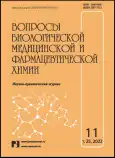Blood xanthine oxidoreductase: activity profile in systemic lupuse erythematosus
- 作者: Mozgovaya E.E.1, Bedina S.A.1, Trofimenko A.S.1, Spitsina S.S.1, Mamus M.A.1, Zborovskaya I.A.1
-
隶属关系:
- Research Institute of Clinical and Experimental Rheumatology named after A.B. Zborovsky
- 期: 卷 25, 编号 11 (2022)
- 页面: 36-41
- 栏目: Articles
- URL: https://journals.eco-vector.com/1560-9596/article/view/113008
- DOI: https://doi.org/10.29296/25877313-2022-11-06
- ID: 113008
如何引用文章
详细
Relevance. Oxidative stress is an integral part of the pathogenesis of systemic lupus erythematosus (SLE). At the same time, hyperproduction of reactive oxygen and nitrogen species prevails over the capabilities of the antioxidant system. Xanthine oxidoreductase (XOR) is an important source of reactive oxygen species, reactive nitrogen species, and nitric oxide. The enzyme exhibits its activity in interconvertible forms: xanthine oxidase (XO; EC 1.17.3.2) and xanthine dehydrogenase (XDG; EC 1.17.1.4).
Objective – analysis of XDH and XO activities profiles in blood depending on the activity of SLE.
Material and methods. 56 SLE (diagnosis of SLE was verified using the EULAR/ACR criteria (2019)) patients and 35 healthy controls were enrolled in this study. Patients with SLE were divided into 3 subgroups, according to the degree of process activity (classification based on clinical manifestations and the SLEDAI 2K index were used). Enzymes activities levels were measured in plasma (KOpl, XDGpl), lysed WBC (KOl, XDGl), and lysed RBC (KOer, XDGer).
Results. The enzyme indices of SLE patients significantly differed from the control values both in blood plasma and in cell lysates. Relationships between the activity levels of the D-form, as well as the O-form of XOR and the SLEDAI 2K index were revealed. The increase in the levels of XOpl, XDGer and a decrease in the levels of XDGpl, XOl, XDGl, XOer were determined on the background of an increase in disease activity. The levels of XO and XDG in plasma and cell lysates differed significantly between subgroups of patients with different SLE activity.
Conclusion. The significant changes in the XOR enzyme system, which depend on the activity of immune inflammation, were revealed in SLE. Changes in the balance of O- and D-forms XOR levels in plasma, lysed WBC and lysed RBC determine the blood profiles characteristic of different activity degrees in SLE.
全文:
作者简介
E. Mozgovaya
Research Institute of Clinical and Experimental Rheumatology named after A.B. Zborovsky
编辑信件的主要联系方式.
Email: nauka@pebma.org
Ph.D. (Med.)
俄罗斯联邦, VolgogradS. Bedina
Research Institute of Clinical and Experimental Rheumatology named after A.B. Zborovsky
Email: nauka@pebma.org
Ph.D. (Med.)
俄罗斯联邦, VolgogradA. Trofimenko
Research Institute of Clinical and Experimental Rheumatology named after A.B. Zborovsky
Email: nauka@pebma.org
Ph.D. (Med.)
俄罗斯联邦, VolgogradS. Spitsina
Research Institute of Clinical and Experimental Rheumatology named after A.B. Zborovsky
Email: nauka@pebma.org
Junior Researcher
俄罗斯联邦, VolgogradM. Mamus
Research Institute of Clinical and Experimental Rheumatology named after A.B. Zborovsky
Email: nauka@pebma.org
Junior Researcher
俄罗斯联邦, VolgogradI. Zborovskaya
Research Institute of Clinical and Experimental Rheumatology named after A.B. Zborovsky
Email: nauka@pebma.org
Dr.Sc. (Med.), Professor
俄罗斯联邦, Volgograd参考
- Solov'ev S.K., Aseeva E.A., Popkova T.V. i dr. Sistemnaja krasnaja volchanka: novye gorizonty diagnostiki i terapii. Nauchno-prakticheskaja revmatologija. 2020; 58(1): 5–14. doi: 10.14412/1995-4484-2020-5-14.
- Nasonov E.L., Lila A.M., Dubinina T.V., Nikitinskaja O.A. Dostizhenija revmatologii v nachale XXI veka. Nauchno-prakticheskaja revmatologija. 2022; 60(1): 5–20. doi: 10.47360/1995-4484-2022-5-20
- Rossijskie klinicheskie rekomendacii. Revmatologija. Pod red. E.L. Nasonova. M.: GJeOTAR-Media, 2019; 461 s.
- Hakberdieva M.S. Sovremennye vzgljady na klassi-fikaciju, patogenez i lechenie sistemnoj krasnoj vol-chanki. Rossijskie biomedicinskie issledovanija. 2019; 4(1): 20–30.
- Smallwood M.J., Nissim A., Knight A.R. et al. Oxidative stress in autoimmune rheumatic diseases. Free Radical Biology & Medicine. 2018; 125: 3–14. doi: 10.1016/j.freeradbiomed.2018.05.086.
- Il'in M.V., Mal'ceva P.A., Volkova A.S. i dr. Jekspressija faktorov okislitel'nogo stressa i apoptoza nejtrofilov pri razvitii disfunkcii miokarda u bol'nyh sistemnoj krasnoj volchankoj i sistemnoj sklerodermiej. Funda-mental'nye issledovanija. 2011; 9(часть 1): 73–5.
- Aringer M., Costenbader K., Daikh D., et al. European League Against Rheumatism/American College of Rheumatology classification criteria for systemic lupus erythe-matosus. Ann Rheum Dis. 2019; 78(9): 1151–1159. doi: 10.1136/annrheumdis-2018- 214819.
- Alekseeva E.I., Dvorjakovskaja T.M., Nikishina I.P. i dr. Sistemnaja krasnaja volchanka: klinicheskie rekomendacii. Chast' 1. Voprosy sovremennoj pediatrii. 2018; 17(1): 19–37. doi: 10.15690/vsp.v17i1.1853.
- Medicinskie laboratornye tehnologii. Rukovodstvo po klinicheskoj laboratornoj diagnostike. Pod red. A.I. Kar-pishhenko. M.: GJeOTAR-Media, 2013; 2: 274–314.
- Mozgovaja E.Je., Bedina S.A., Trofimenko A.S. i dr. Ak-tivnost' ksantinoksidoreduktazy: osobennosti profilja krovi pri sistemnyh zabolevanijah soedinitel'noj tka-ni. Sovremennye problemy nauki i obrazovanija. 2022; 1: URL: https://science-education.ru/article/view?id=31351 (data obrashhenija: 27.12.2021). doi: 10.17513/spno.31351.
- Bedina S.A., Mozgovaja E.Je., Trofimenko A.S. i dr. Ksan-tinoksidoreduktaza limfocitov: zavisimost' aktivnos-ti ot vnesustavnyh projavlenij pri revmatoidnom art-rite. Doktor.Ru. 2022; 21(2): 67–71. doi: 10.31550/1727-2378-2022-21-2-67-71.
- Aleksandrova E.N., Novikov A.A., Verizhnikova Zh.G. i dr. Vzaimosvjaz' profilej antinuklearnyh antitel i citoki-nov pri sistemnoj krasnoj volchanke. Medicinskij alfavit. Serija «Sovremennaja laboratorija». 2019; 3(22): 37–42. doi: 10.33667/2078–5631–2019–3–22(397)-37–42.
- Aleksandrov A.V., Alehina I.Ju., Shilova L.N. i dr. Novye vozmozhnosti ispol'zovanija antitel k ksantinoksidaze i guanindezaminaze dlja vydelenija kliniko-immunologi-cheskih variantov sistemnoj krasnoj volchanki. Sovremennye problemy nauki i obrazovanija. 2016; 3: URL: http://www.science-education.ru/ru/article/view?id=24616 (data obrashhenija: 27.04.2020). doi: 10.17513/spno.24616.
- Men'shhikova E.B., Lankin V.Z., Zenkov N.K. i dr. Okislitel'nyj stress. Prooksidanty i antioksidanty. M.: Slovo. 2006; 556 c.
- Battelli M.G., Musiani S., Tazzari P.L., Stirpe F. Oxidative stress to human lymphocytes by xanthine oxidoreductase activity. Free Radic Res. 2001; 35(6): 665-79. doi: 10.1080/10715760100301191
- Petrov V.A., Beloglazov V.A., Zaharova S.N. Anemija i sistemnaja krasnaja volchanka: istorija odnogo neprostogo diagnoza. Ukraïns'kij revmatologıchnij zhurnal. 2008; 3(33): 65–70.
- Schmidta H.M., Kelleyc E.E., Strauba A.C. The impact of xanthine oxidase (XO) on hemolytic diseases. Redox Biol. 2019; 21: 101072. doi: 10.1016/j.redox.2018.101072.
- Ghosh S.M., Kapil V., Fuentes-Calvo I., et al. Enhanced vasodilator activity of nitrite in hypertension: critical role for erythrocytic xanthine oxidoreductase and translational potential. Randomized Controlled Trial Hy-pertension. 2013; 61(5): 10911102. doi: 10.1161/HYPERTENSIONAHA.111.00933.
补充文件






